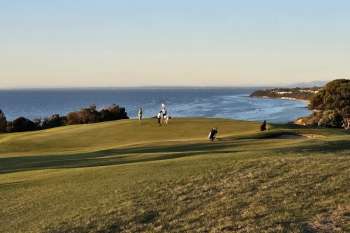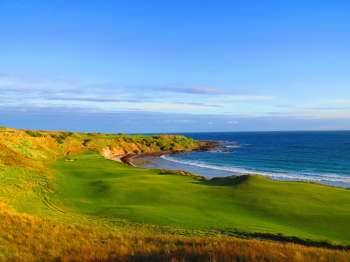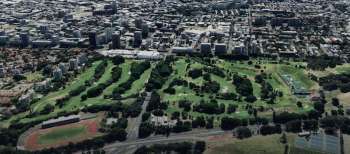Australian Golf Digest - 500th issue Architecture Special
As we celebrate the 500th edition of Australian Golf Digest, it seems appropriate to look back and recognise some of the architectural achievements that have changed the golfing landscape in this country over the past forty odd years.
Golf is a different game today than it was back in the early 1970s, both professionally and in terms of the courses we amateurs play on a regular basis. Our layouts are getting longer and longer, and generally speaking the playing surfaces are better maintained than ever before. In terms of design, it seems that most modern layouts are now cut through housing estates and often ‘designed’ with the assistance of a prominent tournament professional. More than half of the courses listed in our March Top 100 ranking list were not even built when this magazine first hit newsstands in 1970, and more than half of these newcomers were created by prominent signature design companies.
Despite the popularity of high-profile signature design, the number of quality benchmark layouts built during the last 20 years has been impressive. When directly compared to places like Scotland, Ireland and England, modern design in Australia more than holds its own. In fact, the only country with a stronger modern Top 10 would be the USA, which has a golf market that is 20 times the size of ours.
So in keeping with the nostalgic nature of this magazine, listed here are shining examples of modern golf course development and design in Australia.
Best New Public Courses
While the era between World War II and the birth of the Australian Golf Digest magazine was an architectural dark ages of sorts, this most recent period has seen a reawakening of local golfers to the virtues of quality golf on quality golf terrain. Pleasingly, the movement has been driven by public access golf, and it all started with the creation of The Dunes on Melbourne’s Mornington Peninsula. Despite being located more than 75 minutes from the city, The Dunes is surely one of the most popular public courses anywhere in the world with in excess of 60,000 green fee rounds played each year.
The brains behind The Dunes was Duncan Andrews, a small creditor in the failed Limestone Valley golf course that once occupied these rolling sand hills. Andrews recognised the potential of Limestone Valley and purchased the property in the early 1990s, engaging local architect Tony Cashmore to completely rebuild it into The Dunes. With an unbeatable mix of great golf, great value and great terrain, The Dunes was an instant success and proved the catalyst for subsequent development both around Melbourne and all across Australia.
What Andrews started at The Dunes, potato farmer Richard Sattler took to the next level at Barnbougle Dunes in Tasmania. We have written lengthy pieces about both the original Barnbougle course and the newer Lost Farm layout, and with good reason as they have helped transform the sleepy coastal village of Bridport into a genuine global golf destination. By any measure Barnbougle has been an overwhelming success, with both courses regularly ranked among the World’s Top 100 and each attracting substantial green fee traffic. What’s interesting to note, is that last year more golfers paid to play at both Lost Farm and Barnbougle than at Kingsbarns in Scotland, which has an enormous international profile and is situated just a few minutes from the golfing Mecca of St Andrews.
Clearly east coast Australians are happy to travel for their golf, which is not necessarily the case in the west. A dozen or more years back we were trumpeting the arrival of a genuine new links at Port Kennedy south of Perth. Designed by Michael Coate, with help from Roger MacKay and Ian Baker-Finch, Kennedy Bay opened to critical acclaim but endured a number of financial hardships before finding its feet under the current management structure. Kennedy Bay is the sort of course this country needs more of. Its holes are fun, the turf is kept tight and hungry and the green fees are now relatively inexpensive. Plus the Fremantle doctor blows across the site on a daily basis to provide a constant challenge.
The same is true of The Cut, situated nearby at Port Bouvard. Designed by James Wilcher on a superb stretch of seaside dunes, The Cut has a similarly checkered financial history despite being a golf course with significant aesthetic appeal. Originally developed as a private membership club by a property developer who fell into administration, the course was rescued by a group of its members and is now available for visitor play.
Back in Victoria, and another example of the public course golfer benefitting from a failed development is at St Andrews Beach on the Mornington Peninsula, originally designed by Tom Doak and Michael Clayton as part of an exclusive private membership model. The developer of St Andrews Beach also owned Kennedy Bay, and lost both when forced into liquidation a few years ago. Fortuitously for local golfers, St Andrews Beach was purchased by an overseas investor and converted into a modestly priced green fee facility. Together with the two courses at Moonah Links and the two courses across the bay at Thirteenth Beach, the public course golfer in Melbourne has clearly been the big winner when it comes to the modern movement toward affordable, high-quality golf.
Best New Private Courses
Next year The National Golf Club on the Mornington Peninsula will celebrate its 25th birthday, a milestone that is sure to attract plenty of attention across the industry. It was The National in 1988 that introduced the equity-based membership model to Australian golf. The National was also a pioneer in the use of golf carts, but is best remembered for both the size and quality of its golf offerings. From a single, spectacular Robert Trent Jones Jr masterpiece, the National grew to 54 holes in 2000. Two of its courses are entrenched within Australia’s Top 15 while the other, the Ocean course, sits comfortably in the 30 to 40 bracket.
Although the National endured a somewhat wobbly start and its share price has continued to fluctuate over the years, the club has become an Australian golf icon and a game on any of its courses is a genuine treat. Each of the three layouts has a very distinct personality, as well as a passionate and devoted fan base. Many long-time members with a connection to the Old course regard it as the finest in Australia, while the younger brigade tends to gravitate more toward the terrific Moonah course.
From a pure private golf club perspective, the other impressive facility built in recent times is The Grand Golf Club in southeast Queensland. The Grand was the first course designed by Bob Harrison during the formative years of Greg Norman Golf Course Design, and gets far less press than is warranted for such an interesting layout. Strangely the reputation of the course took a hit during the Australian Open in 2001, when professionals and members of the media complained about trees in the middle of a couple of fairways. The logic from some quarters was that 25-yard fairways were fine, but wider holes split by trees were ‘unfair’. Such nonsense took the gloss off what was an exciting event, on a golf course that has some of the finest greens and bunkers outside the Melbourne Sandbelt.
Best Redesigns
When Australian Golf Digest was first published in 1970 The Lakes Golf Club in Sydney was in the midst of a major redesign. American Robert von Hagge was engaged to reconfigure a classic links-style layout being torn apart by a road expansion. The von Hagge routing and his dramatic use of the site’s major lakes warrant consideration in any list of the best redesigns seen in Australia during the life of this magazine. Another strong contender would be the modern Lakes, which was basically rebuilt by Michael Clayton and his partners a few years ago after decades of architectural neglect. Clayton’s team left the von Hagge routing largely intact, but ripped out trees and pot bunkers, and added large sandy wastes and strategically angled green sites to completely transform the overgrown course back to an open, sandy links.
Interestingly, another esteemed golfing establishment that was affected by the construction of Sydney’s Southern Cross Drive in the 1970s finds itself in a similar position to that of The Lakes a few years ago. The Australian Golf Club was once regarded as a fine, inland links with undulating, sandy topography. The nature of the course was completely changed in the mid-70s when Jack Nicklaus set about converting it into an American parkland test, complete with tall Pines, small greens, penal roughs and the first man-made water hazards in Australia. As its slide on our latest rankings would confirm, The Australian (down to 17 from 11) is looking tired and dated these days, and Nicklaus’s company is coming back to spruce up the greens and bunkers. No doubt we will watch developments closely, but after covering up all the sand 40 years ago it was interesting to see that Jack Nicklaus actually wanted to do more than just fix greens and bunkers here, he wanted to inject some of the original, linksy charm back into the place.
Clearly drastic change is a harder sell at The Australian than it was at The Lakes, although the redesign portfolio of Clayton and his team would have made the appointment much easier to justify to the membership. Over the last decade there have been a number of successful redesigns and restorations across the country and the Clayton name has been attached to the vast majority of them. Their work with a modest budget and on a modest piece of land at Royal Queensland was simply superb, as was the redevelopment of the charming but under-appreciated North Course at Peninsula on the Melbourne Sandbelt. According to Peninsula, around 80 per cent of play prior to the redesign was on the longer, tougher South Course but traffic is now effectively spread 50/50 across them both, a ringing endorsement of the work that was done.
Other success stories in recent times include the Victoria Golf Club, where tree removal and the return of lost MacKenzie bunkers and firm playing surfaces has done wonders to improve the playing experience for members and guests. Less high profile but equally noteworthy were changes made to Spring Valley, Healesville, Lake Karrinyup and the West Course at The Grange. Of the other architects, Ross Watson’s redesign of Royal Sydney was mostly well received and certainly helped improve playing conditions there year-round. The same is true of the Graham Marsh changes at Cottesloe, one of the best maintained courses in the west, and the Neil Crafter-led redesign of Glenelg, which is now noted for its striped fairways and eye-catching revetted bunkers.
With an increase in new golf development over the past few decades, the club membership model across Australia has been more competitive than ever before. Whether quality redesign work comes as a result of increased architectural sophistication or simply a desire from one club to keep pace with a successful neighbour, the trend is clearly heading in the right direction and we expect to report on more sensible and sensitive redevelopment projects over the coming years.
Best Residential Estates
As all golfers are well aware, the best residential golf estates are those where houses don’t interfere at all with the golf holes. This is easiest done on low-density developments like The National, Moonah Links and even Joondalup and Thirteenth Beach, where most of the housing is located on the perimeter of the golf property. Sadly few courses these days are afforded the luxury of such space, and designers invariably find themselves working as much on disguising neighbouring properties as disguising features of design. A course like Magenta Shores, for example, would have benefited greatly from more breathing space for its playing corridors, especially as the site is quite windy.
As far as traditional residential golf estates are concerned, Bob Harrison has the best strike rate when it comes to extracting quality golf out of a compromised masterplan. His work with Greg Norman at Sanctuary Lakes, The Vintage, The Glades and Pelican Waters was crucial to the success of each project. One of his most difficult assignments was Brookwater near Ipswich, where a steep site and dense property subdivision forced him to create an exacting test with narrow tree-lined playing corridors. Harrison shaped his fairway edges to be more forgiving than they appear and used splashed-up Sandbelt style bunkers across the property for dramatic visual affect. The sense of seclusion that comes from playing within a forest and not looking directly into people’s homes is a large part of the Brookwater appeal.
Best Resorts
Destination golf is not a new phenomenon in Australia, with Melburnians, for instance, having long travelled to the likes of Barwon Heads, Portsea and Sorrento for their golf. In recent decades the number of quality golf resorts has risen dramatically here, with great options available across the country. For the purists there isn’t anything that beats Bridport in Tasmania, where you can play two cracking golf courses and enjoy the first-class food and hospitality offered at both Barnbougle Dunes and Lost Farm.
Those with non-golf partners or families to consider also have a plethora of options, from the Peppers Resort at Moonah Links to the Barwon Heads Resort at Thirteenth Beach and pure 5-star indulgences at Joondalup in Perth, Hope Island and Hyatt Regency Sanctuary Cove on the Gold Coast and the luxurious Sea Temple Resort and Spa in Port Douglas. Other quality golf / quality lodging combinations include Magenta Shores, Hyatt Regency Coolum and The Sebel Heritage Yarra Valley. Another personal favourite is the Bonville Golf Resort near Coffs Harbour, where an ever-popular resort golf experience is enhanced by an award-winning restaurant and an enchanting tall forest setting.
Each of these golf resorts was conceived, built and opened during the life of this magazine. Over the last 500 issues of Australian Golf Digest, we have helped fix your slice, add distance to your drives, improve your putting and find a new set of clubs. Hopefully we have also encouraged you to discover some of the wonderful golf courses this country has to offer.
Darius Oliver, Architecture Editor
Back to NewsMore News
Report reveals golf's $3.3 billion contribution to Australia
AGIC report reveals total annual benefits to the Australian community, economy and environment from golf.
Cape Wickham Links – The Inside Design Story
Co-designer Darius Oliver reveals the truth behind the design of Australia’s premier modern golf course
Min Woo Lee signs up for Aussie PGA title defence
Reigning champion locks in the defence of his title at Royal Queensland Golf Club in November
Have your say on the future of Moore Park Golf
Golfers unite – another one of our cherished public access golf courses is under threat




